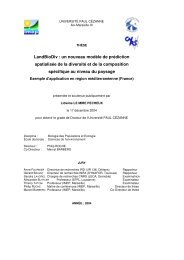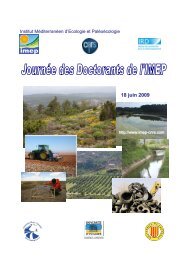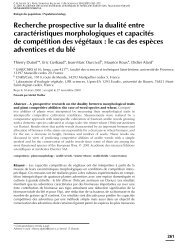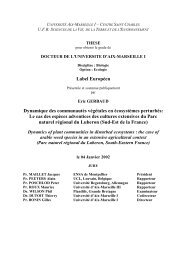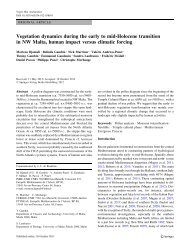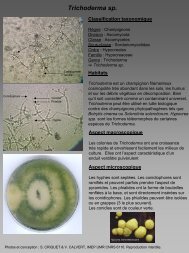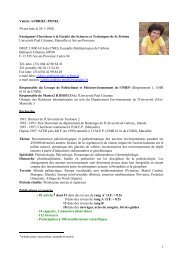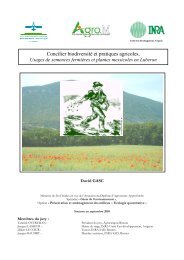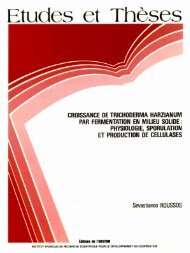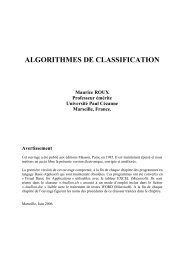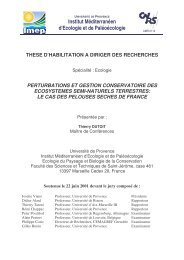UNIVERSITÉ PAUL CÉZANNE, AIX MARSEILLE III - IMEP
UNIVERSITÉ PAUL CÉZANNE, AIX MARSEILLE III - IMEP
UNIVERSITÉ PAUL CÉZANNE, AIX MARSEILLE III - IMEP
Create successful ePaper yourself
Turn your PDF publications into a flip-book with our unique Google optimized e-Paper software.
Résultats et discussion. Chapitre 5: Disponibilité des substrats oléicoles<br />
and centrifuged at 4500 rpm for 10 min. The extraction was repeated three times. The<br />
supernatant was then filtered under vacuum. The non phenolic fraction still presents in the<br />
filtered liquid (e.g. fats) was eliminated by extraction with 10 mL of n-hexane, repeated three<br />
times. The total phenolic content of the remaining aqueous phase was quantified by the<br />
method of Folin and Ciocalteu (Bärlocher et al., 2005). The blue reactive complex formed<br />
was dosed spectrophotometrically at 760 nm. Caffeic acid being used as standard for the<br />
calibration, the phenolic content of the samples was expressed as caffeic acid equivalent.<br />
2.6. NMR analysis of dried crude olive cake and OC-OMW mixture<br />
Dried crude OC and the mixture OC-OMW were used directly in NMR experiments<br />
without special preparation. Owing to their size, the samples were gently ground (IKA<br />
Labortechnik, Germany) in order to fill the rotor. Solid-state 13 C CPMAS NMR spectra, of<br />
dried crude OC and dried mixture OC-OMW, were obtained on a Bruker Avance-400 MHz<br />
spectrometer (Bruker, Bremen, Germany) operating at a 13 C resonance frequency of<br />
100.7 MHz. Samples were placed in a 7-mm zirconium rotor and spun at the magic-angle at<br />
6 kHz. All measurements were made at room temperature. The 13 C chemical shifts were<br />
referenced to tetramethylsilane and calibrated with the glycine carbonyl signal, set at<br />
172.5 ppm.<br />
Deconvolution of the NMR spectra was performed using the DmFit software (Massiot<br />
et al., 2002). This software adjusts the spectra to obtain the linewidth and the peak positions<br />
(in ppm) and to integrate each peak so as to obtain the percentage of each contribution. The<br />
aromaticity of dried mixture OC-OMW and crude OC was calculated by expressing aromatic<br />
C (110–165 ppm) as a percentage of aliphatic C (0–110 ppm) + aromatic C (Wikberg and<br />
Liisa Maunu, 2004). The lignin content was calculated according to the model of Gilardi et al.<br />
(1995), which takes into account the total lignin carbon. These authors calibrated lignin<br />
content from aromatic carbons plus aliphatic carbons of lignin. The cellulose crystallinity (Xc)<br />
was expressed by the ratio between the signal at 84 ppm, assigned to the C-4 of amorphous<br />
cellulose, and the signal at 89 ppm, assigned to the C-4 of crystalline cellulose (Newman and<br />
Hemmingson, 1990).<br />
2.7. Statistical treatment of results<br />
Data of drying, chemical analysis and NMR spectra were subjected to analysis of<br />
variance (ANOVA). The error square was obtained from the analysis of variance and used to<br />
calculated the least significant difference (LSD, P=0.05). Variations between data are<br />
significant when the difference between is more than the LSD.<br />
133



